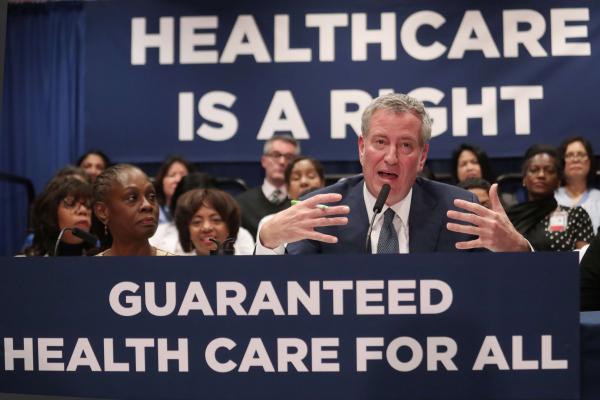In his interview with Rep. Alexandria Ocasio-Cortez (D-N.Y.) on 60 Minutes this past weekend, Anderson Cooper listed all of the new Congresswoman’s policy goals, including universal health insurance.
“How are you going to pay for all this?” he asked.
It’s a fair question. But it’s also one for which Medicare for All advocates now have the answer.
The core argument in favor of universal health care is the moral one, especially for people of faith. 26-year-old Alec Smith of Minnesota died in 2017 because he could not afford insulin. That is immoral. It is also immoral that 20-year-old Sarah Broughton of California died because she could not afford treatment for a sinus infection before it spread, and that Hedda Martin of Michigan was rejected for a heart transplant and directed to conduct a private fundraiser to cover costs.
With 100 million people in the U.S. uninsured or underinsured, we know that nearly two-thirds of Americans defer or skip needed health care each year due to cost. Thousands die as a result. And we know that other nations with single-payer health care have better outcomes at a lower cost than we do. Our current system is a moral failure. We must change it.
But it is also legitimate to ask, as Cooper did, what that change will cost. So it is exciting to see that the Political Economy Research Institute (PERI) at the University of Massachusetts-Amherst recently completed the most comprehensive, authoritative analysis of the costs and benefits of a Medicare for All system.
They did the math, and we have the results: the U.S. can provide universal, comprehensive, no-copay, no-deductible coverage at a cost that is $5.1 trillion less than we pay now. There are powerful forces dead set on retaining the profit-soaked status quo, so the argument that single-payer health care will cost too much will not magically disappear. But, as the saying goes, those of us favoring universal coverage now “have the receipts.”
Let me provide a quick overview of the calculations in the 200-plus page PERI/UMass report. A Medicare for All system will lead to an increase in people accessing care, an undeniably good thing that nevertheless will raise our health care spending by about $400 billion a year. But that increased cost is more than offset by the huge annual savings of $700 billion from cutting out for-profit insurance’s bloated administrative costs, profits and marketing, along with reduced pharmaceutical and provider spending.
Under Medicare for All, premiums, co-pays, and deductibles that cause so much suffering and even death will disappear. In their place will be government investment of $1.05 trillion a year. The PERI study includes that cost, and also factors in the price of retraining and/or providing pension guarantees and wage replacement to 800,000 displaced private insurance industry workers, along with the inevitable administrative cost of transition to a new program. PERI proposes that these costs be covered by revenue from taxes on individual net worth of over $1 million plus premiums paid by large businesses at a rate less than what they currently pay for their employees’ health care.
There are far more granular details in the PERI report, of course. And the precise levels and targets of such taxes will need to be decided in the legislative sausage-making. But the numbers add up. And the question, “How can we afford it?” is answered, thoroughly and persuasively.
Although the PERI-UMass study is the most comprehensive demonstration of Medicare for All cost savings, it is not the first. The U.S. General Accounting Office and Congressional Budget Office have come to the same conclusion, and the far-superior financial ledgers of single-payer programs in other countries show it, too. Even the conservative Mercatus Center study in 2018, initially trumpeted as showing the high price for Medicare for All, was revealed to conclude it would save $2 trillion compared to our current system.
Again, these results are to be expected. If you think of health care spending as a pipeline running from the money we all pay to the care we receive, our current system’s waste represents a massive diversion of that pipeline. We allow health insurance company CEO salaries, shareholder profits, and marketing budgets to drain away our health care resources. A pre-schooler can identify the waste in a system like ours, as well as the obvious value in stopping that for-profit diversion.
It is possible to have a life without health care co-pays, deductibles, and premiums. It is possible to live in a country where we no longer watch our neighbors and loved ones suffer and even die because they cannot afford the care they need and deserve. And now we have an academically and economically rigorous study that proves it.
Got something to say about what you're reading? We value your feedback!






